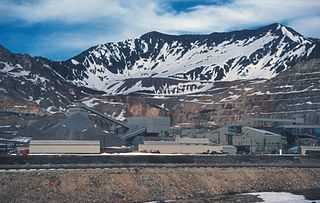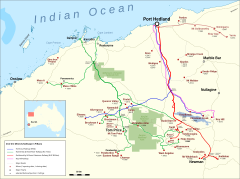
The Pilbara is a large, dry, thinly populated region in the north of Western Australia. It is known for its Aboriginal peoples; its ancient landscapes; the red earth; its vast mineral deposits, in particular iron ore; and as a global biodiversity hotspot for subterranean fauna.

Codelco is a Chilean state owned copper mining company. It was formed in 1976 from foreign-owned copper companies that were nationalised in 1971.
KGHM Polska Miedź S.A., commonly known as KGHM, is a Polish multinational corporation that employs near 34,000 people around the world and has been a leader in copper and silver production for more than 50 years. In 1991, the company was established as a state enterprise and since 1997, their shares have been traded on the Warsaw Stock Exchange. Currently, KGHM operates 9 open-pit and underground mines located in Poland, Canada, the USA and Chile and is actively advancing 4 projects. KGHM produces key global resources including copper, copper sulphate, gold, silver, nickel, nickel sulphate, molybdenum, rhenium, lead, sulphuric acid, selenium and platinum group metals.
Arrium was an Australian mining and materials company. The company employed nearly 10,000 workers. In April 2016 the company went into voluntary administration with debts of more than $2 billion. In September 2017 it was acquired by British-owned GFG Alliance.

Mining in Western Australia, together with the petroleum industry in the state, accounted for 92 per cent of the State's and 41% of Australia's income from total merchandise exports in 2015–16. The state of Western Australia hosted 111 principal mining projects and hundreds of smaller quarries and mines. The principal projects produced more than 99 per cent of the industry's total sales value.

Mining in Iran is underdeveloped, yet the country is one of the most important mineral producers in the world, ranked among 15 major mineral-rich countries, holding some 68 types of minerals, 37 billion tonnes of proven reserves and more than 57 billion tonnes of potential reserves worth $770 billion in 2014. Mineral production contributes only 0.6 per cent to the country's GDP. Add other mining-related industries and this figure increases to just four per cent (2005). Many factors have contributed to this, namely lack of suitable infrastructure, legal barriers, exploration difficulties, and government control over all resources.

Mount Isa Mines Limited ("MIM") operates the Mount Isa copper, lead, zinc and silver mines near Mount Isa, Queensland, Australia as part of the Glencore group of companies. For a brief period in 1980, MIM was Australia's largest company. It has pioneered several significant mining industry innovations, including the Isa Process copper refining technology, the Isasmelt smelting technology, and the IsaMill fine grinding technology, and it also commercialized the Jameson Cell column flotation technology.

Copper mining in the United States has been a major industry since the rise of the northern Michigan copper district in the 1840s. In 2017 the United States produced 1.27 million metric tonnes of copper, worth $8 billion, making it the world's fourth largest copper producer, after Chile, China, and Peru. Copper was produced from 23 mines in the US. Top copper producing states in 2014 were Arizona, Utah, New Mexico, Nevada, and Montana. Minor production also came from Idaho, and Missouri. As of 2014, the US had 45 million tonnes of known remaining reserves of copper, the fifth largest known copper reserves in the world, after Chile, Australia, Peru, and Mexico.

Fortescue Metals Group Ltd is an Australian iron ore company. Fortescue is the fourth largest iron ore producer in the world among BHP Billiton, Rio Tinto and Vale. The company has holdings of more than 87,000 km² in the Pilbara region of Western Australia making it the largest tenement holder in the state, larger than both BHP Billiton and Rio Tinto.

The mineral industry is one of the main sectors of the Armenian economy and in 2017 accounted for 30.1% of its exports.

The Climax mine, located in Climax, Colorado, United States, is a major molybdenum mine in Lake and Summit counties, Colorado. Shipments from the mine began in 1915. At its highest output, the Climax mine was the largest molybdenum mine in the world, and for many years it supplied three-fourths of the world's supply of molybdenum.
Northparkes is a copper and gold mine in central New South Wales, Australia, approximately 27 kilometres north-northwest of the town of Parkes. The mine was originally started in 1994 using open pit mining, with underground mining using the block caving method starting in 1997. The mine has an operational capacity to process six million tonnes of ore per year, containing roughly 60,000 tonnes of copper and 50,000 ounces of gold. Economic viability of the mine is projected to extend at least to the year 2032.
Turquoise Hill Resources is a Canadian mineral exploration and development company headquartered in Vancouver, British Columbia. Its focus is on the Pacific Rim where it is in the process of developing several large mines, the principal one being the Oyu Tolgoi Project in Southern Mongolia 200 km east of Dalanzadgad. The company was called Ivanhoe Mines until August 2, 2012 when an important financing agreement was made with Rio Tinto.

The Cloudbreak mine is an iron ore mine located in the Pilbara region of Western Australia, 89 kilometres west-south-west of Nullagine, in the Chichester Range.

Iron ore mining in Western Australia, in the financial year 2008-09, accounted for 47 percent of the total value of the state's resources, with a value of A$33.56 billion. The overall value of the mineral and petroleum industry in Western Australia was A$71.3 billion in 2008-09, a 19 percent increase compared to the previous financial year.

Thompson Creek Metals Company Inc. was a full cycle mining company with acquisition, exploration, development, and operation in North America. The corporate office was located in Denver, Colorado. The company primarily produced copper, gold, and molybdenum. Over its history, the Company evolved from being a major primary molybdenum producer to becoming a copper and gold mining company with the construction and development of the Mount Milligan mine and concentrator in British Columbia, Canada. Mount Milligan was Thompson Creek Metals principal operation and the company owned 100% of this property. The company also owned 100% of its Thompson Creek Mine in Idaho. Thompson Creek Metals owned 75% joint venture interest in two other properties, including its Endako Mine in British Columbia, and its Langeloth Metallurgical Facility (roaster) in Pennsylvania. Thompson Creek Metals had additional development projects, including the Berg property in British Columbia.

The Yarrie mine is an iron ore mine located in the Pilbara region of Western Australia, 90 kilometres north-east of Marble Bar.
Mining in North Korea is important to the country's economy. North Korea is naturally abundant in metals such as magnesite, zinc, tungsten, and iron; with magnesite resources of 6 billion tonnes, particularly in the Hamgyeong-do and Jagang-do provinces. However, often these cannot be mined due to the acute shortage of electricity in the country, as well as the lack of proper tools to mine these materials and an antiquated industrial base. Coal, iron ore, limestone, and magnesite deposits are larger than other mineral commodities. Mining joint ventures with other countries include China, Canada, Egypt, and South Korea.
The Toromocho mine is a large copper mine in the center of Peru, in Junín Region. Toromocho represents one of the largest copper reserve in Peru and in the world having estimated reserves of 1.52 billion tonnes of ore grading 0.48% copper, 0.019% molybdenum and 336 million oz of silver.
Cu-River Mining Pty. Ltd. is a privately-owned Australian resources company with interests in iron ore mining and port development projects in South Australia. It is the smaller of two iron ore exporters operating in the state, the larger being the GFG Alliance. The company is owned by Adelaide-based businessman, Yong Gang Shan and as of 2019 its only producing asset is the Cairn Hill mine in the state's Far North. The company has contracted mining, processing and freight logistics services to Jiujiang Mining Australia.
















